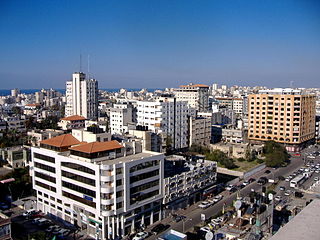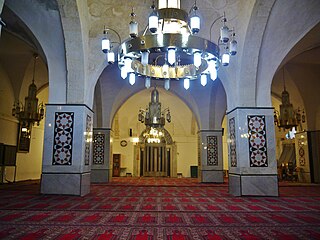
Gaza, also referred to as Gaza City, is a Palestinian city in the Gaza Strip, with a population of 590,481, making it the largest city in the State of Palestine. Inhabited since at least the 15th century BCE, Gaza has been dominated by several different peoples and empires throughout its history.

Deir al-Balah or Deir al Balah is a Palestinian city in the central Gaza Strip and the administrative capital of the Deir el-Balah Governorate. It is located over 14 kilometers (8.7 mi) south of Gaza City. The city had a population of 54,439 in 2007. The city is known for its date palms, after which it is named.

Qaqun was a Palestinian Arab village located 6 kilometers (3.7 mi) northwest of the city of Tulkarm at the only entrance to Mount Nablus from the coastal Sharon plain.

The Great Mosque of Gaza, also known as the Great Omari Mosque is the largest and oldest mosque in the Gaza Strip, located in Gaza's old city, in the State of Palestine.
Katib al-Wilaya Mosque or Welayat Mosque is a small historic mosque located along Omar Mukhtar Street in Gaza City in the Zaytun Quarter of the Old City. The mosque was built by the Burji Mamluks in 1432, however, the structure could date further back to 1344. Additions to the western part of the mosque were commissioned in 1584 by Ahmed Bey, the Ottoman clerk of the Damascus Vilayet. Damascus Vilayet's Arabic transliteration is Wilayat Dimashq, hence the name of the mosque Katib al-Wilaya.

Shuja'iyya, also Shejaiya, Shijaiyeh, Shujayya, Shuja'ia, Shuja'iya, is a neighborhood district of the Palestinian city of Gaza and one of the largest neighborhoods in Gaza with 92,000 to 100,000 residents. It is located east of Gaza's city center, and its nucleus is situated on a hill located across the main Salah al-Din Road that runs north-south throughout the Gaza Strip. Shuja'iyya contains several ancient structures, mosques and tombs. The Commonwealth War Cemetery is located 2 kilometres (1.2 mi) north of the commercial center of the neighborhood.
The Ibn Marwan Mosque is a Mamluk-era mosque in Gaza in the midst of a cemetery in the Tuffah neighborhood, relatively isolated from the rest of the city. Inside is the tomb of a holy man named Sheikh Ali ibn Marwan who belonged to the Hasani family. The Hasani family came from Morocco and settled in Gaza where Ibn Marwan died in 1314 CE. The cemetery is also named after Ibn Marwan. The mosque itself was built in 1324. The Ibn Marwan Mosque contains an oratory and the stones of the tombs in the adjacent cemetery are believed to contain historical inscriptions.

The known history of Gaza spans 4,000 years. Gaza was ruled, destroyed and repopulated by various dynasties, empires, and peoples. Originally a Canaanite settlement, it came under the control of the ancient Egyptians for roughly 350 years before being conquered and becoming one of the Philistines' principal cities. Gaza became part of the Assyrian Empire around 730 BCE. Alexander the Great besieged and captured the city in 332 BCE. Most of the inhabitants were killed during the assault, and the city, which became a center for Hellenistic learning and philosophy, was resettled by nearby Bedouins. The area changed hands regularly between two Greek successor-kingdoms, the Seleucids of Syria and the Ptolemies of Egypt, until it was besieged and taken by the Hasmoneans in 96 BCE.
The Ibn Uthman Mosque is a mosque in Gaza City, in the Gaza Strip, Palestine. It is regarded as second only to the Great Mosque of Gaza in terms of beauty and status as a Friday mosque. Noted for its architectural patterns, the mosque was established in three different stages during the Burji Mamluk period of rule in Gaza.

Bayt Tima was a Palestinian Arab village in the Gaza Subdistrict, located 21 kilometers (13 mi) northeast of Gaza and some 12 kilometers (7.5 mi) from the coastline. It was situated in flat terrain on the southern coastal plain of Palestine. Bayt Tima was depopulated during the 1948 Arab-Israeli War. Its population in 1945 was 1,060.

Jisr Jindas, Arabic for "Jindas Bridge", also known as Baybars Bridge, was built in 1273 CE. It crosses a small wadi, known in Hebrew as the Ayalon River, on the old road leading south to Lod and Ramla. The bridge is named after the village of Jindas, which until 1948 stood east of the bridge and may have been the Crusader-period "casal of Gendas" mentioned in a Latin charter dated 1129 CE. It is the most famous of the several bridges erected by Sultan Baybars in Palestine, which include the Yibna and the Isdud bridges.

Al-Daraj or Haraat al-Daraj is the densely populated northwestern quarter of Gaza's Old City. Its name translates as "Quarter of the Steps." Situated on an oblong hill about 20 meters (66 ft) above sea level and higher than any other area in the city, al-Daraj likely received its name either from stairs that once led to it or from the feeling of climbing steps when attempting to reach the neighborhood. It is also referred to as the "Muslim Quarter" and contains several mosques and other Muslim edifices. Among them are the city's largest mosque, the Great Omari Mosque, as well as the al-Sayed Hashem Mosque, the Sheikh Zakariya Mosque, the Sheikh Faraj Mosque and Madrasa al-Zahrah. Al-Daraj is separated from the southern Zaytun Quarter by Omar Mukhtar Street.
Sanjar ibn Abdullah Alam al-Din Abu Sa'id al-Jawli was a powerful Mamluk emir and the Governor of Gaza and much of Palestine between 1311–20 during the sultanate of an-Nasir Muhammad and then again for a brief time in 1342 during the reign of the latter's son as-Salih Ismail. Prior to his first term as governor, al-Jawli briefly served as the Emir of Shawbak in Transjordan and before his second term as Gaza's governor, he was appointed Governor of Hama for three months.

Al-Jawali Mosque or Amir Sanjar al-Jawli Mosque is a mosque in Hebron, Palestine, located in the southwestern corner of the Old City and part of the Ibrahimi Mosque sanctuary.
Al-Aybaki Mosque is a historic mosque situated in the al-Tuffah neighborhood of Gaza City, Palestine. Built by the Mamluks in the late 13th century, the mosque is named after Sheikh Abdullah al-Aybaki, a Muslim religious leader. According to his nisba "Aybaki", Sheikh Abdullah was a mamluk or relative of Izz al-Din Aybak, the first Mamluk sultan of Egypt. Sheikh Abdullah's son Sheikh Iyad was buried nearby at the Sayed al-Hashim Mosque in al-Daraj while his other son Ahmad al-Aybaki, a local saintly person, was buried in a sanctuary called al-Mazar ash-Sheikh Aybak.
The Mahkamah Mosque was a congregational mosque and madrasa, built in 1455, destroyed by Israeli bombing during the attack on Gaza in 2014. The mosque was located along Baghdad Street near the main western entrance of the Shuja'iyya district in Gaza City, Palestine.
Rukn ad-Din Baybars al-Ala'i al-Hajib was a prominent mamluk of Bahri sultan al-Nasir Muhammad in the early 14th-century. He served as the governor of a number of provinces throughout the Cairo-based Mamluk Sultanate.
Sayf ad-Din Taynal an-Nasiri al-Ashrafi was a prominent emir and mamluk of an-Nasir Muhammad, the Bahri Mamluk sultan of Egypt. He served as the Na'ib of Tripoli for three terms, and Gaza for one term, in the mid-14th-century during the reign of al-Nasir Muhammad. He ordered the construction of the large Taynal Mosque in Tripoli in 1336.
Sayf al-Dīn Salār al-Manṣūrī was the viceroy of the Mamluk sultan al-Nasir Muhammad during the latter's second reign (1299–1310). As a boy he was taken captive at the Battle of Elbistan in 1277 and became a mamluk of the emir al-Salih Ali and eleven years later by the latter's father Sultan Qalawun. Salar distinguished himself in his training as a skilled horseman among other mamluks of the Mansuriyya faction. He was promoted to the rank of ustadar (majordomo) by his friend, Sultan Lajin in 1299. After participating in Lajin's assassination later that year he effectively became the strongman of the sultanate alongside Baybars al-Jashankir. Despite tensions and incidents between their respective factions, Salar and Baybars avoided direct conflict throughout their power-sharing arrangement. Salar continued as viceroy when Baybars acceded as sultan in 1309 after al-Nasir Muhammad stepped down and exiled himself. After Baybars was deposed in 1310, al-Nasir Muhammad returned to power and Salar was consequently imprisoned and starved to death. His sons and grandsons became middle-ranking emirs of al-Nasir Muhammad and his successors.









